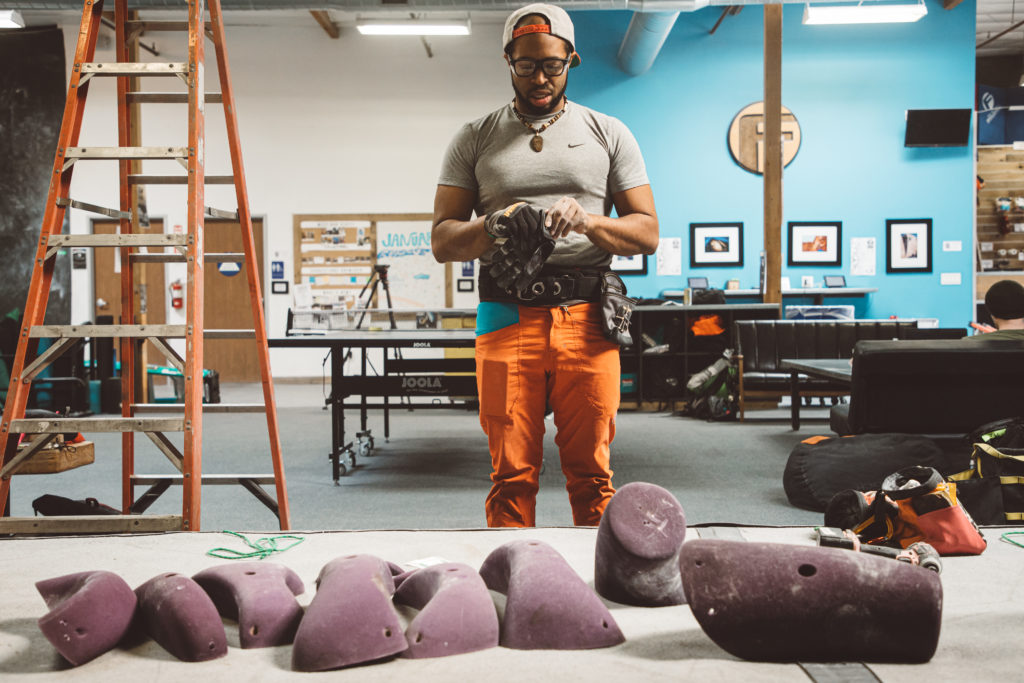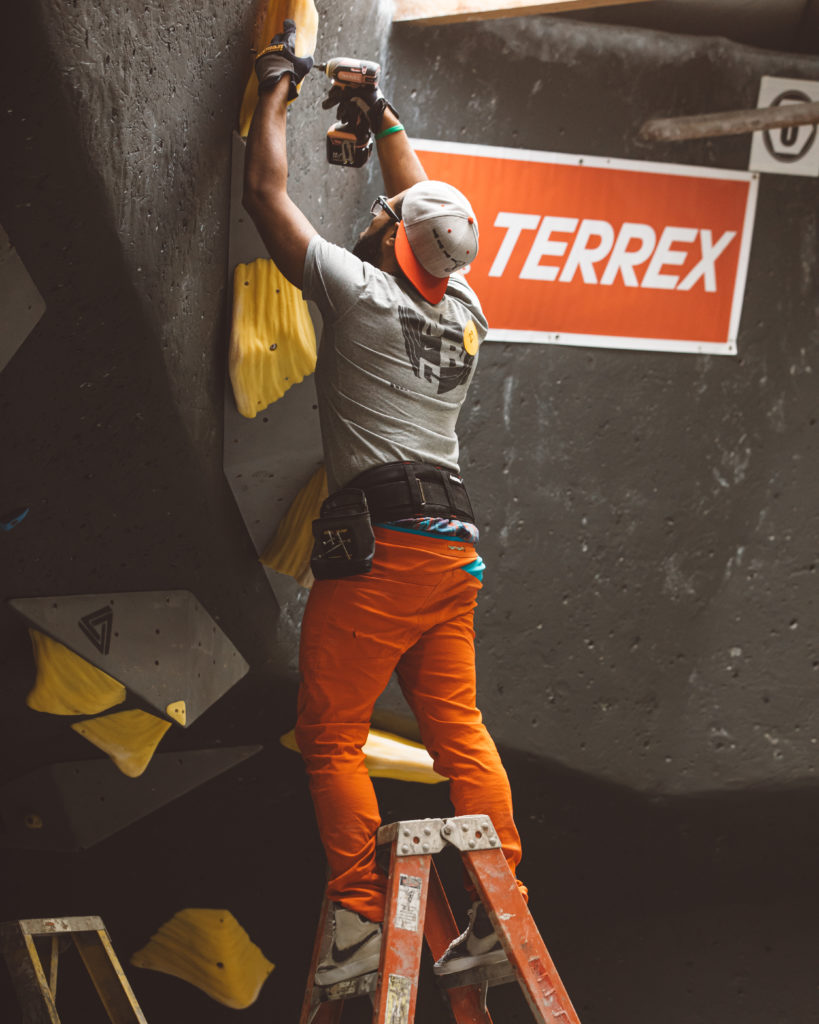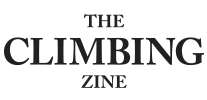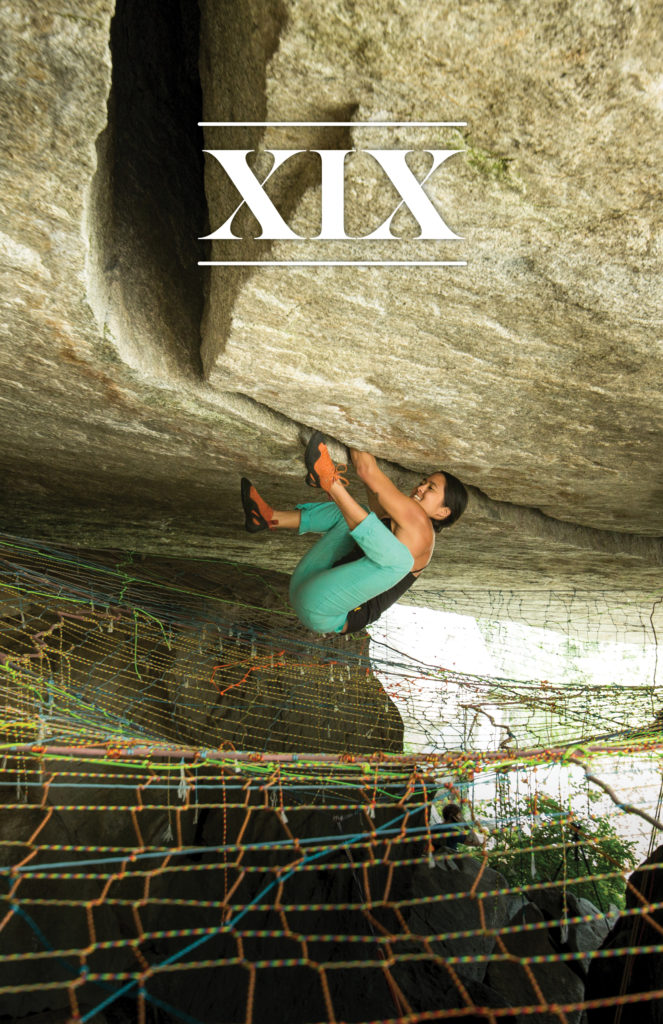The Factory Bouldering Gym in Orange, California, was by no means small, but it felt small that day. In addition to us thirty-one routesetters, there were about thirty or so people that were siphoning in for their late-afternoon sessions. The judges had just passed out our results and were preparing to announce the winners and their prizes. I had a beer in my hand and the accompanying I’m done climbing wristband on my arm.
This piece is published in Volume 19, now available. Banner image of the author by Vivian Dao.
I told myself that the scores didn’t matter to me, and I meant it. At the end of the day, I already considered myself a winner for even entering the Setter Showdown. An annual competition of routesetting between a couple dozen of the country’s best setters sounds terrifying, even as I type it. Not only am I putting myself out there, I’m also being judged by other people—quite literally—and that’s one of my greatest fears. I never would have considered doing something like it eight years ago, or five years ago, or even last year. Simply having the self-confidence to apply for it was my victory, knowing that I may not even get accepted to compete.
That being said, when I saw the scores, I still felt a spark of validation, because even though I didn’t win, I’d actually done pretty well. It created a warmth in my chest that spread all the way down to my fingertips. I knew these numbers carried no real weight—after all, routesetting quality is largely subjective, and the past two days were hardly a sliver of representation for anyone’s setting prowess, let alone my own. But still, I felt pretty cool.
Then, I folded up that sheet of paper and forgot about it. Once I did that, I knew I had truly won the Setter Showdown.
The story I’d like to tell you is about how that small act took ten years of personal growth—growth that I found through climbing. It’s also about the second, equally significant period of growth I’ve experienced in the months following that moment, while being quarantined and watching the world light itself ablaze.
To understand this story, you have to understand why climbing is my passion. It has nothing to do with athletic performance, thrill seeking, or really even the act of climbing itself. Those things are all great parts of it that I love, but this sport gave me something much more important than all those: a journey to self-acceptance. I say “journey” because I’ve still got a long way to go…but I would be remiss if I didn’t explain to you just how far I’ve come.
Climbing came to me at the lowest point of my life—a point punctuated with a suicide note, an intervention from my closest friends, and the start of me visiting a therapist. I was not in a good place. I hated myself, and I envied people who seemed to have it all together. But most of all, despite my greatest efforts to be the best at everything I did, I never felt like enough—good enough, smart enough, attractive enough, Black enough, you name it. I never had a lot of confidence growing up, and it didn’t help that I never really fit in anywhere. I was a smart Black kid from a lower middle class family—a boy that was into superheroes, drawing, and classical music. I never felt like any space was for me—not even where I lived—so when I was thrust into the climbing world by eager friends in my twenties, I quickly caught on to something they had, something I wanted. It was a feeling of universal acceptance—something I’d been missing out on forever, though I never considered how it impacted me until I experienced it. For the first time in my life, I felt I had friends that were accepting of my weirdness, and in a lot of ways liked me more because of it. The community of climbing was the true draw for me, and in retrospect, I realize I was very lucky to have this experience as a Black man, because it sold me on the sport. And in 2012, I took a friend up on their offer to climb outside in the Red River Gorge. On the last day of classes, we headed straight there, and after that trip, I knew this was going to be a part of my life forever.
I’d like to say there was some profound and revelatory thought I had during my first outdoor climbing trip, but honestly, it was just the collection of feelings each experience gave me. It was the mental silence I felt when fully focused on executing a climb or the tranquility of cleaning a route as I looked out on the Gorge. There was the deep satisfaction in hiking out of Muir Valley knowing we’d climbed ten plus routes that day at multiple crags and feeling like I’d earned that whole pizza I knew I was gonna eat. There was the social warmth of a campfire, the odd run-ins with locals—I could go on for days. Throughout all of those things, the only discomfort I felt was with the heights—not with how I dressed, talked, acted, or looked. People were friendly, accepting, and generous. I thought, THESE are my people. They’ve been hiding under a rock this whole time. And very quickly after that trip, my big question became: How do I make this my life? Thankfully, soon after that, I began developing my universal bridge to connect myself to other climbers: the art of routesetting.
Routesetting is, and always has been, my default language of climbing. It’s my way of homogenizing into the climbing community, of being a teacher, and of giving back to the sport I love. It’s also my way of constantly being connected to the sport, thus giving myself a sense of validity as a climber. In a lot of ways, routesetting pairs me to white culture in the way that being a rapper pairs me to Black culture. I think I truly figured out its importance to me at the end of 2014—when I graduated college. I had long given up on my dream to be a rapper and was working as a landscape designer while setting once a week at one of the local gyms. That summer, my ring finger A2 had surrendered with a loud pop, and a few weeks after that, my girlfriend wanted to see other people. Not long after that, I was fired from my designer job, but honestly it was for the best—I hated it. And though I loved routesetting way more, at that point, it wasn’t a viable career for me. But the longer I thought about that, the less it mattered. This feeling brought me to decide something I still hold true to now: I would rather struggle financially to do something I love doing every day than have a stable job that is miserable or even just okay. “Okay” was not okay with me anymore, thanks to climbing.
That’s when I went all in. The gym I set once a week at didn’t need full-time setters, so I settled for three days a week. I picked up a second near-full-time job at a Life Time Fitness climbing wall, where I would set and coach. I was making a few cents above minimum wage at both, so I took up a third job as an architectural photographer to make the wages livable. I worked seven days a week (some days for twelve plus hours) for over a year, and my setting days were brutal sometimes, but I was way happier. I had found a path of creativity, constant change, and direct impact upon my sport. I felt that I mattered.
Unfortunately, finding a passion is not the same as finding oneself, and so I soon suffered from my old problems with self-confidence and self-worth. I began doubting my skills, wondering if I could ever measure up as a “great” routesetter. Without even really understanding what “great” meant in the setting world, I still needed to find a way to prove my skills—to be labeled “the best.” I climbed constantly to improve—oftentimes to the point of accidental injury. I tirelessly compared myself to the people I worked with—people who were all in killer shape, doing things I could not, and so sure of themselves. My validity as a climber began to intertwine with my skills as a setter, and as a result, I still often question if I’m a “real” climber or if I’m just another gumby greasing up the holds. This would continue on for years, and my relationship with the sport slowly turned toxic.

The author preparing to set his “easy” boulder for the Setter Showdown. They were randomly assigned hold sets, and he was lucky enough to get these Kilter holds, some of his favorites. Photo: Katie Jo Meyers
No matter what role I took—head setter, instructor, personal trainer, youth coach—my inner critic grew more powerful, and each time I learned a new skill to run away from it, a shadow of insecurity followed that skill. I was never satisfied with myself, and it began to show in my work. I became afraid to experiment in routesetting, only setting moves I knew would work. I started getting nervous to climb around other people and would intentionally isolate myself, unless I was climbing well below my limit and could look smooth doing it. Soon that anxiety became a paralyzing fear, and I felt too nervous to project anything, even when I was alone…and before long, I was so scared of failure that I could no longer climb outside. What’s worse, it seemed like the more I tried to isolate my climbing, the more friends wanted to climb with me. My training was paying off, and I was getting stronger, but as my strength grew, so did my friends’ expectations. “I’ve gotta put you on this 12c—you’ll totally crush it.” Or, “You should try this 6—you’ll flash it.” And, “You need to try harder on a rope—you’d be such a crusher.” I was addicted to the sport, but it had become a bad addiction—one that rewarded self-deprecation and punished vulnerability.
It only seems fitting that around this time, I began a romantic partnership that would only amplify those very problems. This partnership would have been toxic on its own, but it also further damaged my outlook on climbing. When she finally dumped me three years later, I was left alone in Portland—a city across the country from my hometown, dominated by white people who, as “woke” as they were, did not understand me or my experiences. I felt isolated but also special. It was a mirror of my situation in college, but this time I had climbing to support me, and I was nowhere near contemplating suicide. Still, I came to realize my relationship with climbing was a parallel of my relationship with who I am—I didn’t love climbing because I didn’t love myself. I needed to rebuild it from scratch, starting with climbing for fun—not to get stronger for my job and not to understand grades (which is impossible, by the way). I needed to peel back the onion of self-deprecation, one layer at a time.
After my breakup, I moved in with some friends who let me stay with them for cheap while I regrouped. I began climbing for fun, and I started running. I also found another sport to play strictly for fun: tennis. I spent the entire summer and fall focused on myself, and somewhere along the line, a close friend of mine sent me the Setter Showdown application. I didn’t necessarily feel like I was good enough to get in, and honestly that probably made it easier for me to just say “screw it” and apply without expecting a response, but of course, life has a way of surprising us, and it surprised me with an acceptance letter. Thankfully, as the date got closer, I slowly became the strongest and most confident I’d ever been in climbing…but then one day, while stemming in a dihedral, I heard the sound of a dozen wet rubber bands snapping as my arm bent the wrong way. I’d torn muscles in my arm, and was told I’d be sidelined for four months minimum. That was in late October, and the showdown was in January.
Surprisingly, I took this horrible injury in stride, but I knew the implications it had for the Showdown. Even if I could still technically do it, I couldn’t climb at all, but despite knowing this and that it would affect my scores, I decided to go anyway. I didn’t realize it then, but I think that was the first time I learned to show up exactly as I am. That didn’t mean I wasn’t nervous or worried about being terrible at routesetting, but it did mean that, for once, I had fully accepted where I was at that point in time, and I was still willing to continue on anyway. And thankfully, my decision to put myself out there in a vulnerable state was well rewarded with a fun experience, amazing people, great conversations, and a chance to build my own lightsaber (crossed that off the bucket list!). As we all know, this is not always the case when you put yourself out there, which makes doing it a constant challenge. And as we’ve all seen in 2020, America has been forced to confront the role it plays in scaring some of us (like myself) from showing up as we are: through a systemic, structural breed of racism.
I’ve long thought about how race plays a part in climbing culture, but sadly, I’ve also long kept my mouth shut about it. Part of that was because I was afraid to be rejected by my white friends who couldn’t empathize with me, but I also greatly feared backlash from Black people. “He’s not even Black—how can he speak to the Black experience?” My self-hate and fear kept me in check for over a decade, and I’m ashamed to say that if we hadn’t seen a sudden shift in white America’s attention to race, I maybe never would have had the courage to speak out like I have been. But right now, the world has made it very hard for us to ignore these horrors as a country any longer. We all watched George Floyd get lynched on our television screens, and now we are watching my new hometown, Portland, be set afire by our own federal government. This is a terrifying time for me (and so many more of us), but for me, it’s also been a revelatory time. This year has provided me a chance to unplug from the racism matrix—to face the issues I’ve buried under years of chasing skills and acceptance. It’s given me a new life force that I’d long suppressed, and a new brotherhood I didn’t know I could ever have; in a few short weeks, I’ve connected to more Black people than I have the last fifteen years. There’re times I’ve been amidst talking to amazing people, like Mario Stanley or Diamond Jones, and suddenly just burst into tears. I remember moving the phone away from my face so they couldn’t hear me, because I was embarrassed to be crying in front of people I’d just met. But the fact of the matter is, I shouldn’t have been embarrassed. I was so starved for the simple acknowledgment of my Black identity, much less acceptance for it, and now I’m getting both in abundance. Of course I should break down and cry like a baby. I feel like a man who’s wandered the desert for days and suddenly found an oasis of Ale-8, ha-ha. With that, I can only hope we as a community of color can continue to connect with each other and form the network I’m sure we’ve all desperately needed for so long. I think if we can do that, the future of climbing will be much brighter (and also much darker, but skin-tone wise).
This lockdown has also been an empowering time for me, and in a lot of ways, it’s inspired me to treat my life path as a call-to-action of sorts for others. I now know that I want my voice to not only amplify the Black experience, but I also want it to raise the bar for the average climber’s experience. I want to challenge the cultural norms we’ve let play out and use myself as a humanly imperfect road map for authenticity in our sport—authenticity that we should all aim for, in my opinion. My music has always been a mainstay for me expressing my form of climbing culture, and I’ve always used my teaching skills and relationship skills to forge the community I want. But now I want to take it a step further. I want to use my voice to create a focus on real rock climbers—the everyman of all colors, creeds, and crimp strengths. Too long have I been complicit existing in a world that was not made for me, that’s run by people who don’t look like me, and uplifts people with resources and opportunities that I and so many others do not get. No longer will I feel survivor’s guilt because I fought for a good education, made a career in routesetting, and became what I wanted in life while so many of my friends and loved ones ended up trapped in the system. I’m going to use my voice in any way I can—be it music, poetry, articles, podcasts, or media—to disrupt the climbing status quo and raise the bar higher for what we accept out of the sport we all love. And through all of that, I’d like rock climbing as a whole to learn one simple thing:
Show up as you are.

The author working on the “partner” boulder for the Setter Showdown, where he worked with Will Flores—a setter he didn’t know before that day but who is now one of his favorite people. Also, peep the Nikes! Customized by the author! Photo: Katie Jo Meyers
That’s the lesson I’m focused on for the future of climbing—especially as we continue to speak on DEI, gender equality, and what the world will see when they look at climbing (because the world is already starting to look at us). What will our cultural impact be? Currently, all we have in the world’s eyes is Free Solo, but what maxims do we as climbers stand for at large? Will we continue to solely praise the archetype of “climbing gods” sending Mt. Olympus, or will we also begin to tell the stories of real climbers—ones with flaws, issues, and limitations? Will the cover of our mainstream magazines always feature a shirtless white dude snagging the hardest new FA, or will we see a Black woman like Mélise Edwards who is a superhero of climbing, neuroscience, biology, and racial equity? In twenty years, will I still be scared to go to HP40 without a white counterpart, or will I freely roll there in droves with my Black brothers and sisters? And will we still treat women climbers as assets without agency, expecting them to fit our impossible standards for climbing femininity while also not offering them respect or fairness? These are very hard questions to answer, but I do think the answer starts with all of us showing up as we are now—not hiding behind virtue signaling, saying the right thing, or being scared to post a bouldering video because you don’t “look strong.” In my dream world, rock climbing would be known by the world as a sport that embraces living in the moment with pure authenticity, enjoyment of the process, and just a little bit of caution thrown to the wind (because after all, this shit is dangerous). Our culture would reflect the holistic experience of the sport, rather than the tired trope of “acceptance” through achievements and image…and it would reflect a realistic, diverse image of our population. We as climbers are part of a futuristic way of life, and thus our culture’s focus should be on futuristic representation.
A few months ago—pre-quarantine—I was leaving a grocery store in Portland, and I ran into another Black person, which is an extreme rarity out here. He was an older man, slightly taller than me, with soft features. We both smiled and gave each other “the nod,” after which he said, “Another brother—that’s what’s up.” I smiled even wider, and a warm feeling spread in my chest. That was when I realized it was the same feeling I got when I looked at my scores from the Setter Showdown: validation. It felt good to have someone genuinely and respectfully acknowledge my race—that despite my greatest subconscious fears, I was still Black. I thought about the parallels between my struggle for value as a climber and my struggle for value as a Black man and how interesting that was. But little did I know, that was my first sip from the Fountain of Truth—something that I could have only understood after a decade of bolting plastic to plywood. And now that I’ve begun to fully drink it in, I’m determined to make sure the well never runs dry.
Devin Dabney is a routesetter, teacher, rapper, and creativity polymath who aims to bring the climbing community together through our shared experiences. You can find his climbing rap music on deuceishiphop.bandcamp.com and his original music on Spotify. You can also follow his stream of creative obsessions on his Instagram: @deuceishiphop.








